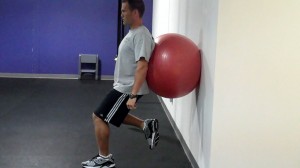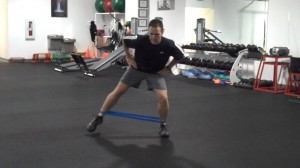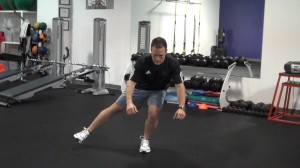Brian Schiff’s Blog
Injury Prevention, Sports Rehab & Performance Training Expert
Anterior knee pain, aka chondromalacia, patellofemoral pain (PFP) and patellofemoral pain syndrome (PFPS), may be the most difficult condition to remedy in the clinic or gym. There is always debate and speculation when it comes to taping, bracing, orthotics and exercise.
In the latest edition of the JOSPT, there was a summary from the findings presented at an international retreat held in the spring of 2009 in Maryland. The publication covered the keynote addresses and podium presentations.
Before I give you the quick and dirty details, I want to emphasize a key point that was made and one I happen to wholeheartedly agree with. It is this:
When assessing and evaluating those with PFPS, it is important to recognize that these patients/clients do not necessarily fit under one broad classification system. The anterior knee pain issue is multi-factorial and not every person has the same issues or abnormalities. As such, the exercise prescription most likely will need to be tweaked accordingly for best results.
Okay, now on to the highlights that may impact your training/rehab. Some researchers from Belgium have been conducting prospective studies looking at intrinsic risk factors for developing PFPS. They looked at physical education students and novice runners. Major findings are included below:
Study #1
There were 4 variables identified as risk factors:
- Decreased flexibility of the quadriceps
- Decreased explosive strength of the quadriceps
- Altered neuromuscular coordination b/w the vastus lateralis (VL) and vastus medialis oblique (VMO)
- Hypermobility of the patella
Study #2
- More laterally directed plantar pressure distribution at initial (foot) contact during walking and more laterally directed rollover are risk factors for developing PFPS
Study #3
- Unable to link hip muscle strength (or weakness) to increasing risk for PFPS
- No apparent correlation with frontal plane motion of the knee and hip strength (so hip weakness will not automatically cause knee pain)
Finally, what does this mean for therapists and fitness pros? It means…….
- They should address the 4 intrinsic risk factors by stretching and strengthening the quads, with a particular emphasis on balancing the VMO strength in relation to VL strength. This is not new information. Spending time on closed chain terminal range strengthening is important.
- Second, keenly observing a dynamic disturbance in foot alignment at contact is important for predicting PFPS and will undoubtedly impact dynamic training protocols for the entire kinetic chain.
- Lastly, continue to strengthen the hip even though the final study revealed no apparent link. However, perhaps focus more on this when there is a definitive weakness side-to-side that has been identified. So, don’t fall back on the weak gluteus medius by default; rather use dysfunction as a driver for exercise inclusion.
PFPS is and will continue to be a difficult problem to treat and remedy with exercise. Further research is needed to determine and evaluate more specific gender differences, kinetic chain links, the efficacy of taping/bracing, and the most effective classification and treatment algorithms for those of us in the trenches. In the meantime, listen to the body and use the best available science and information to move forward with your training.
Reference: JOSPT March 2010
If you have been following my blog, you are aware one of my marathoners has been battling increased medial knee pain. I initially suspected and diagnosed it as patello-femoral irritation. I have known she has some chondromalacia (softening or weakening of the cartilage behind the kneecap) ever since I began training her 2 years ago.
I spoke with the MD Thursday and he confirmed by MRI she has no meniscus tear and just patello-femoral arthritis and inflammation. I was relieved to know I had hit the mark (remember the chiro said meniscus tear). The MD I referred my client to wants me to do a specific PF strengthening program with her. The good news – no surgery needed that will derail training for the Columbus Marathon. The bad news – she may have to contend with some discomfort related to the pounding for now.
It is always hard to tell a runner to rest. That is one four letter word that really ticks them off! So, the answer for my client is relative rest (avoiding excess mileage, not running down too many hills, and increasing recovery windows when possible) as well as implementing a more specific PF rehab program.
We have been doing lots of quad (VMO specifically) work and gluteus medius strengthening already. So, what I will be adding or changing? Well, we will be integrating more repetitively the following:
- Weighted straight leg raises in flexion and adduction
- Modified box step-downs in the terminal range of knee extension to emphasize VMO contraction in a closed chain manner
- Modified lunge and squat progressions working around the pain
I will be continuing with single leg strengthening for glutes, hamstrings and quads, while challenging hip stability in the frontal plane as she may be experiencing unwanted force transmission here with impact. Additionally, I will continue with IT band rolling/stretching and hamstring flexibility.
This client is tough and will run through the pain if need be. My job is to reduce and eliminate the pain without taking her running away. That is never easy but it can be done with careful progression of exercise and cooperation from the client. The key point for strength and conditioning specialists is to modify programming based on the client, while the key point for all runners out there is to be open and honest about pain, as well as willing to comply with modifications in the short term training plan to achieve the same long term goal – finishing the race.
Below is a picture of a modified squat progression (an isometric single leg stability ball wall squat/sit). I use this exercise with athletes and runners with patello-femoral pain issues when they can’t squat due to pain. If you want to see exactly how to do this exercise, subscribe to PFP Magazine and read my online column, Functionally Fit, here. My newest column will be out next week and address double and single leg isometric squats for patello-femoral pain.

Shallow Single Leg Wall Sit
So, my client saw the orthopodic doctor I sent her to on Wednesday. He called me and said he felt it was primarily patello-femoral arthritis and some irritation of the medial retinaculum (fold of tissue along the inside portion fo the kneecap). When I pressed him about the mensicus (remember the chiro suspected this injury), he felt my client at 35 was young to have an attritional meniscus tear, but he did decide to get an MRI to be 100% sure she did not have a tear of the medial meniscus.
For now, the plan is to let her run and train with me while we await the results fo the MRI and progress training based upon her pain/symptoms. So, what are good exercises for PF pain in runners? Obviously, I focus a great deal on strengthening the hip musculature, particularly the gluteus medius, as well as the quads and hamstrings. Essentially, reducing the amount of pronation, valgus load at the knee, and IT Band tigthness is important for female runners.
Below is a list of a few key exercises I include in this particular marathoner’s routine with me:
- Single leg stiff-legged dead lifts
- Single leg squats with opposite leg hip/knee drive
- Lateral ankle band walks
- Single leg lateral reaches
- IT Band foam rolling
Note: It may be necessary to modify the range of motion on single leg squats based on pain or specific hot spots on the kneecap. In this case, I typically work above or below the pain zone. I included pictures of the lateral band walks and lateral reach below (these really target the gluteus medius).

Lateral Band Walk

Single Leg Lateral Reach
Have you ever experienced sudden intense anterior knee pain or pain along either the medial or lateral joint line? What about catching, popping or locking? Well, if so you are not alone. Many people suffer from patello-femoral pain and meniscus tears.
I am currently working with a marathoner who recently ran her own personal best 3:34 at the Boston Marathon. She has had various overuse injuries over the few years I have worked with her as distance runners often do. However, after I came back from vacation the second week of this month she had an increased pain along the medial part of her knee. It all began after running hills 5 days in the same week.
My initial thought was she probably had increased inflammation of the patello-femoral joint as all the downhill running creates a more compressive load between the back of the knee cap and the femur. Not to mention 5 days in one week was simply too much. Needless to say I did not advise her to do as much.
Her initial exam revealed some mild medial joint line tenderness, no swelling and no gait deviation. Her biggest issue was with squatting below 45 degrees and pain near the medial border of the patella. She also had no pain with rotation of the knee with that foot fixed on the ground (I was particularly looking at valgus loading with rotation to tweak the medial meniscus). My initial assumption was that the pain would resolve with relative rest and minimizing compression at the P-F joint.
Relative rest really does not enter into the realm of reality for marathoners. So, my client continues to complain of knee pain after running (not so much during). Her chiropractor feels she may have torn her medial meniscus. I re-evaluated her yesterday. Findings: mild medial joint line tenderness, no swelling, no locking, negative Apley compression and McMurray testing. But, she did have pain with internal rotation of the femur when standing on just the affected leg. Hmmm???
Now, most meniscus tears occur with trauma that typically involves twisting and compression or an associated ACL tear. However, in runners, the repetitive nature of running can cause a gradual degeneration of the meniscus particularly if there is arthritis present in the knee. For more info on meniscus tears click here.
So, she will be seeing the sports medicine doc next week. She may have a small tear. She may just have an irritated P-F joint. She may have both. The take home message is really this: the most sensitive test for meniscus tears (whether medial or lateral) is joint line tenderness so we need to be sure in her case. If you work with female clients, you can safely bet most of them will have some form of patello-femoral arthritis by the time they are in their thirties. If they are overweight, the relative chances and rate of progression are simply higher.
I will keep you posted on the verdict with my client as she does not have a straightforward case in my opinion. She exhibits an inconsistent pattern of symptoms so I am not willing to rule out the tear at this point. Regardless, this situation calls for rest (as much as she will concede to), modification of strengthening to reduce P-F compression, and also evaluating hamstring work greater than 90 degrees as this too will pull on the menisci and can potentially increase pain and strain on that tissue. Stay tuned and keep your knees fit!
As I prepare to launch my new arthritis DVD to the general public on May 11, I wanted to give you an effective exercise (included in the actual program) using a simple box to improve quad strength. In this three part progression, you should begin with a 4 inch box. The order (easiest to hardest) is:
- Posterior box step-down – in this version you lower the whole foot or toe of the non support leg to the floor and then return to upright. As it gets easier attempt to only lightly touch down and reduce upper body support.
- Lateral box step-down – in this version you still keep the knee in line or behind the toes and lower the non support leg’s heel to the floor and then return to upright.
- Anterior box step-down – this is the hardest version because the weight shifts forward taking the knee over the toes (yes this is allowed in this case as it simulates descending stairs) and puts more emphasis on the quad muscle and less on the glutes and hamstrings. Again, lightly touch the heel to the ground.
In the video below, I will demonstrate how to do all three progressions with light upper body assistance. Once the knee is strong enough and pain free, eliminate upper body support completely as this will challenge proprioception and stability as well. Remember to work only in a pain free range of motion.
If you want to grab a copy of the arthritis DVD on sale, head over to www.fitknees.com as the price goes up on May 11 with the official launch.


